Refinish Mid Century Dining Table
You know, I really wasn't sure of the fate of this $15 mid-century modern buffet by Bassett Furniture. It was an outrageous yard sale find, that I knew, and that's why I swept it up, but after taking some measurements I realized that it wouldn't fit in our dining room without knocking down walls. Or our living room, where it could have had potential as a sideboard. Or in the office, where it might make for nice storage. Our house is actually… small.

Permanent placement aside, like I showed you last Wednesday, it was in pretty rough shape, particularly the buffet top which had both heavy scratches (I'm talkin'deep) and bad water stains.

Those damages didn't really factor into my decision to buy the piece, and that's partially because when I said "SOLD" the whole buffet was still covered with other for-sale items like light fixtures and vinyl records, but also partially because I didn't mind a nick here or there; so what, it looks weathered and loved, so does half of the stuff in our house right now. But after getting it home, and cleaning it down thoroughly with a triple-threat of bleach spray (to take care of some mold inside the cabinet door), Goo Gone (for a sticker that had been long adhered to the top), and Murphy Oil Soap (to see how much I might be able to buff and polish it up myself), I figured I had nothing to lose if I were to sand down the flat surfaces and re-poly it.
So, sand it down, I did. I started with a fine grade sandpaper and Pete's multi-cutter with the sanding attachment (the same do-gooder that I employed when I was sanding down the kitchen cabinet sample). The fine paper was OK for breaking the finish and curing the shallow scratches, but it wasn't nearly enough oomph for the larger scratches and barely made any improvement to the serious water stain on the buffet top.

Deciding to use the super heavy-duty high-grit sandpaper, the job went on much better. I took it easy, applied even weight to the multi-tool, and was intent on moving only with the grain to keep the finish looking neat; I've found that when you start to go perpendicular to the grain, the sandpaper leaves perma-scratches that are perceivable to the eye and to the touch.
My, my, those hands look manly. They're mine, I swear, but check out those bulging veins and forearm muscles? Girl needs a DIY mani.

In hindsight, mochas at 9AM in 90-degree heat are gross. Barf. But I was making good progress, right?
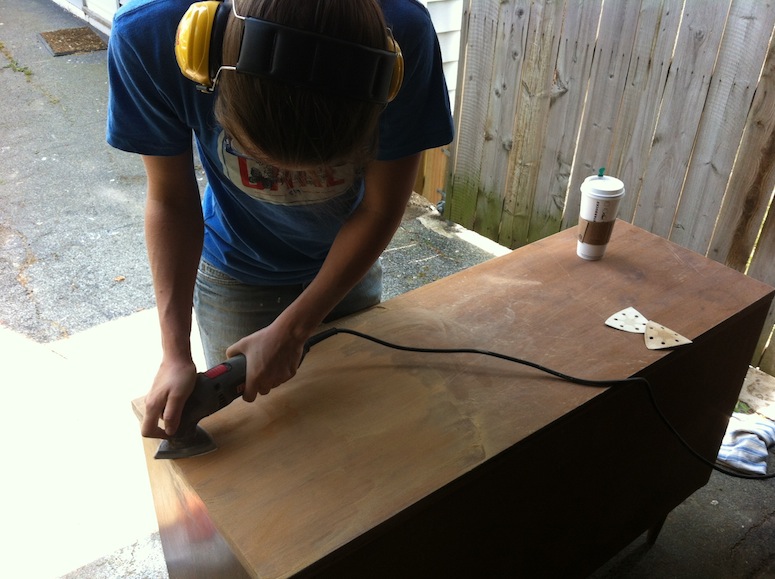
It was apparent pretty early in the sanding process that if I sanded the top, I really needed to sand the sides, door, and drawer fronts too for consistency. An hour and a half in, I stepped back for a moment to try and get my hands to a non-convulsive state, and the sight was pretty impressive. It was one of those "there's no turning back, and we also better go pick out some new stain" moments.

With the flat drawer fronts also then sanded, we made a concerted effort to buy stain that was as close to the original finish as possible, mainly because the beveled areas between each drawer and along the sides of the the buffet were a little trickier to access with a power sander, but they also weren't in bad condition or dented, so I hoped to leave them as-is and just re-stain and refinish the flat panels.
I bought three things at the store, with some affiliate links to amazon:
- Tack cloths ($3, as recommended to get the sanded wood particles and any dust off the surface pre-staining and finishing)
- Pre-stain wood conditioner ($8, a product that I've never used, but have been advised to in the past; it's like a primer for softer hardwoods, coating the grains first and allowing the stain to absorb over it more consistently)
- Oil-based stain in English Chestnut($4, decidedly the closest we could match the existing wood finish based on a poorly-lit iPhone snapshop, ooh, smell the foreshadowing)
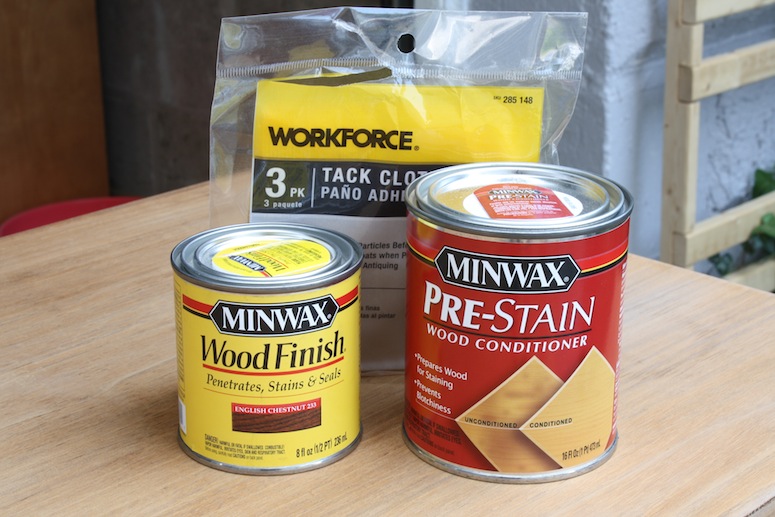
For the record, in doing this project I also used on-hand materials:
- Sandpaper (both rough and fine, power-tool-based and hand-based)
- Gloss Polyurethane (a Rust-Oleum Ultimate product)
- A paint brush (for the pre-stain)
- Rags (terrycloth and absorbent for consistent stain application)
Before I got down to conditioning the wood, I wanted to do one last round of sanding with fine sandpaper. To make the stray grains stand more upright on the wood, I dampened a rag and wiped down all surfaces.
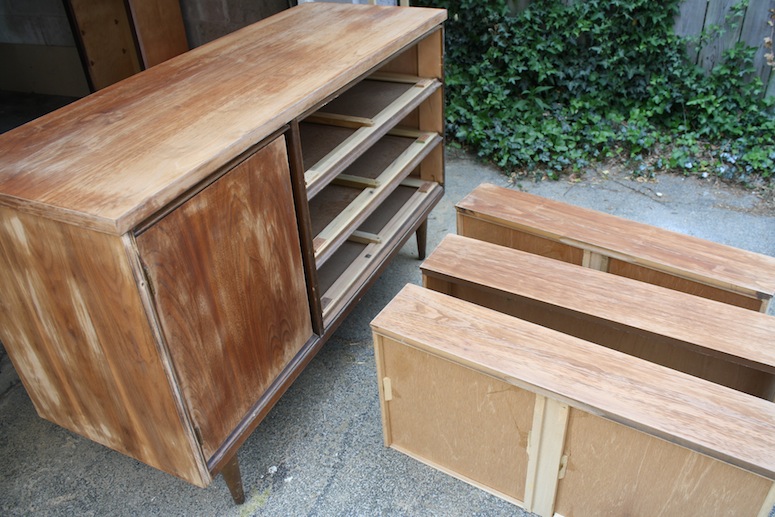
After a few minutes in the heat of the afternoon, the surface had dried and exposed new fine grains that I was able to smooth down further with a fine-grade sandpaper and the multi-tool attachment. Going back over it left it in a pristinely smooth condition, so note to self: always do that, especially with the upcoming kitchen cabinets.
As I mentioned, it was my first rendezvous with pre-stain wood conditioner, a product that was shockingly red and watery when I opened the can for the first time.

The instructions suggested using a rag or brush to apply; I chose a paint brush for ease of application after testing with a rag. Following some simple tips, I ran it on smoothly, thoroughly, and quickly, but not in a way where there was excessive pooling, just aiming to coat the entire to-be-stained surface. If you're wondering, that entire pint of conditioner is going to go a really long way, maybe lasting the rest of my DIY-loving life, and this is how it looks when it's applied soaking wet:
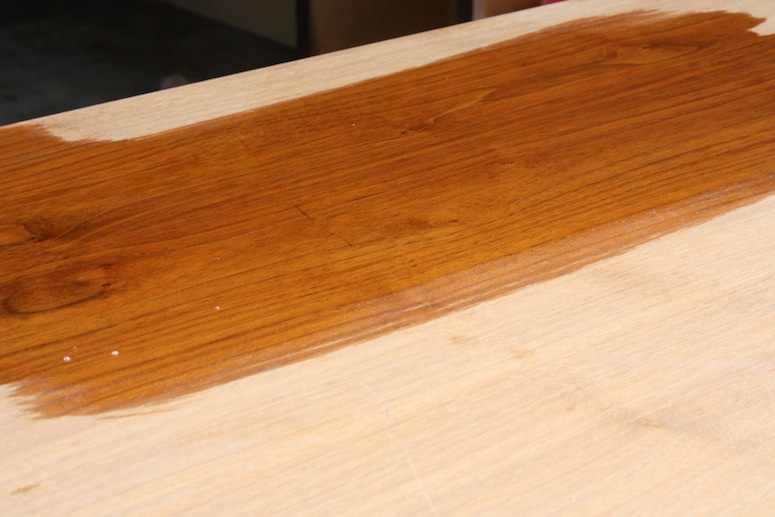
Also per directions, I gave all surfaces a wipe down with a clean rag about 10-15 minutes after application. It still appeared slightly wet in this picture, but was drying quickly.

I don't know why I'm so nervous when it comes to staining, but I was in this instance too. With the wood conditioned, I will say that the stain went on much easier than any other stain I've ever applied in my life (how's that for a big fat w-o-w?), and using a rag on the entire job made it feel very controllable and consistent compared to experiences with foam brushes or paint brushes. The motions were more that of cleaning the kitchen countertop with rag than painting a surface.
There was a funny picture of me wincing and crossing my fingers for good luck as I got started, but you could see a little too far down my shirt and this isn't that kind of blog, so I'll show you this one instead:

And this picture too, as I got a little further along. Let's count how many wardrobe changes I made over the course of this day; two already shown, and I know with certainty that there was another outfit in between from when I scooted to The Home Depot. What can I say, I do a lot of laundry. But isn't this first coat of stain going on pretty nicely?

It's probably the first time that I've really put an effort into keeping the coat of stain light. With all of the shiplap wall paneling I've done, I had been intent on keeping the wood really dark, and therefore was more heavy-handed and less-inclined to massage the stain into the grain or wipe off excess. This was different. And it was obvious.

I know this post is becoming ungodly long, so I'll skip ahead to the third (or fourth) wardrobe change of the post (although it was actually on Day 3 of the project, after I had let the stain dry a bit in the garage for two days and then moved all of the pieces into the sunroom).
I've used Rust-Oleum water-based Ultimate Polyurethane for several projects, most recently, when refinishing the new sunroom table, and really like it for a few reasons:
- It's a pinch to apply, and has serious self-leveling power
- It's super quick dry (<2 hours, usually, depending on humidity)
- It has a durable finish (in my experiences)
When I'm applying it, I start by rolling it on with a 6″ foam roller (and notice how pasty white my springtime legs are, and also how there are random dog toys all over from a puppy I recently dogsat). After it's rolled on, I then go over it with a paint brush really, really lightly just to even it out any bubbles and make it look a little more painted on:
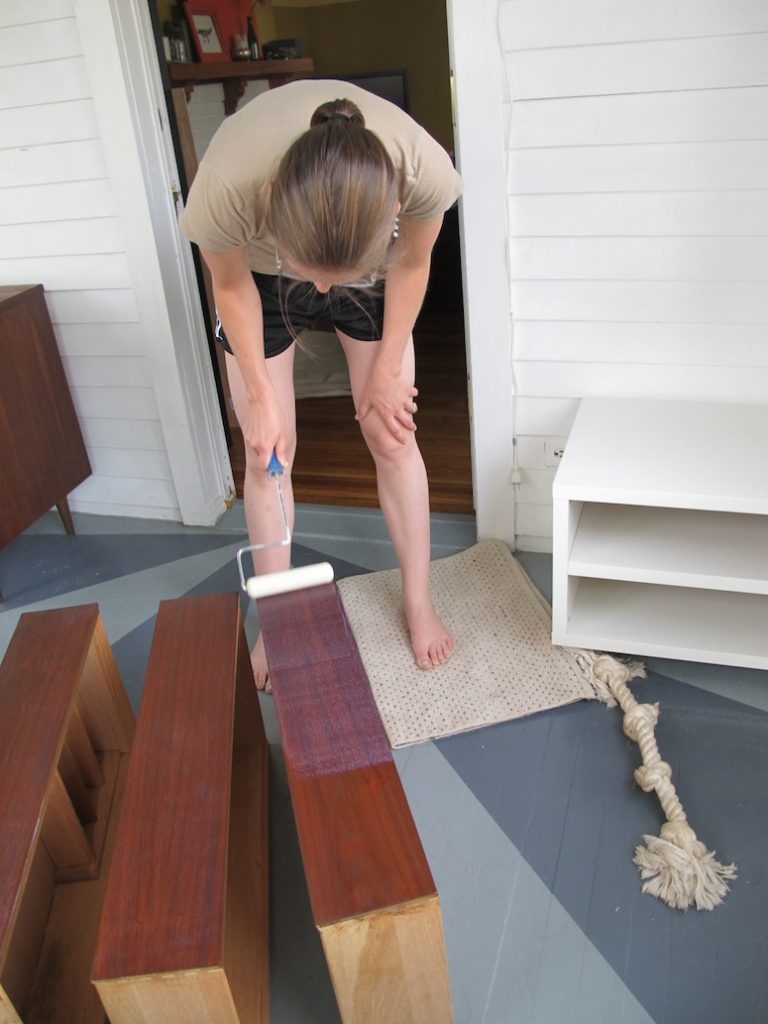
See how it looks a little purple? That's mostly an effect of the poly reflecting the color of the stain, and it helps to make sure you have good coverage, but it certainly dries clearly.

Now, as you might have noticed by now, the English Chestnut stain is a lot different from what the original finish looked like. Not that it isn't pretty now, I just really wanted it to match. Oops.

Because of this variance, I needed to refinish the legs and go into the beveled areas after the original staining and strip the finish so that I could re-stain them in the same color. I used a combination of common sand paper to get in the tight spaces by hand (using both rough and fine stock), but used a sanding bit on Pete's Dremel to bite through most of the accessible finish. It worked pretty well.

Re-staining these crevices was easy too; using the same dampened rag technique, application was smooth, there was just one issue: it seems as though the wood used on these beveled areas is different from what was used on the outer facing drawers and large surfaces. Whomp, whomp. Can you see the difference between the lower piece of trim and the beveled edge after a few coats of stain trying to even them out?
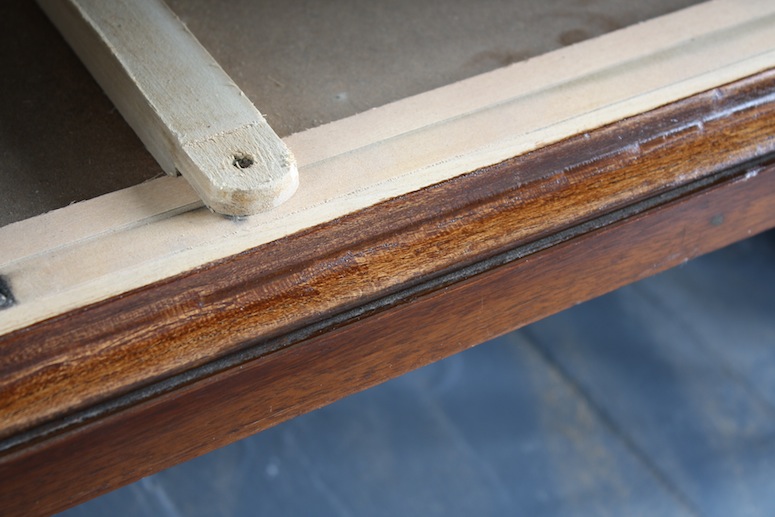
Making it match as best as I could manage, I forged ahead to try and not let it get to me. After all, these pieces of trim are mostly covered in the shadows of the door and drawer. And really, the rest of the buffet looked bitchin'.

Remember what it looked like when I started? When the dog was making crazy eyes at me for bringing home more furniture?
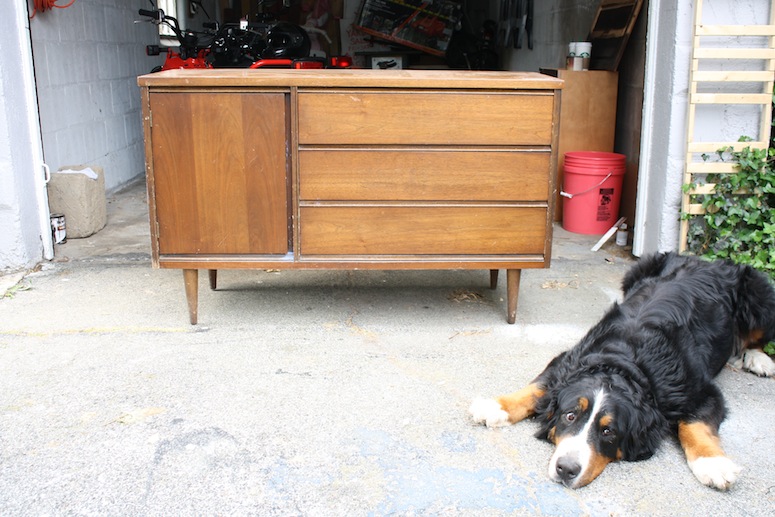
The sunroom ended up being our favorite place for it. Against the sunburst floor and wooden walls, it feels like it really fits in and can be enjoyed in the space that we work in on warm days.
And from the left.

And from the right. Oohs, ahhs.

The drawers are still empty, but I finally have permission to buy a few nice table accessories knowing that I have a place to put them.
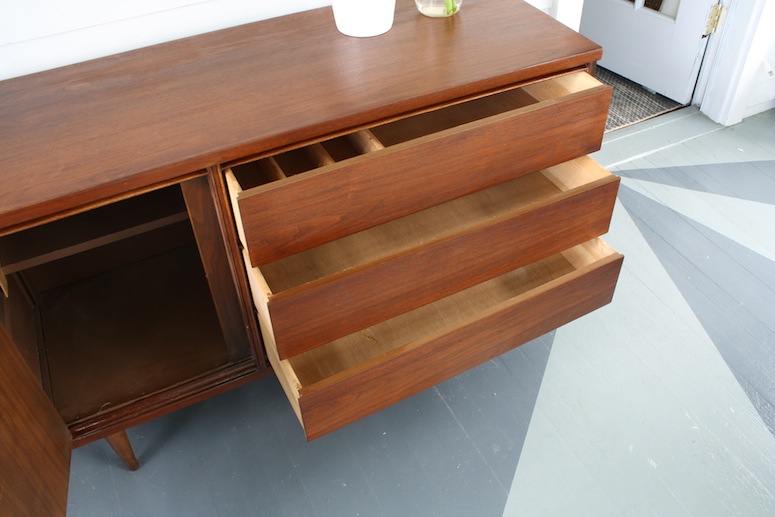
And again, now that we have a table and chairs in the sunroom, it's really nice to have a place to put summertime dining accessories and a surface on which we can put out a buffet of food someday.
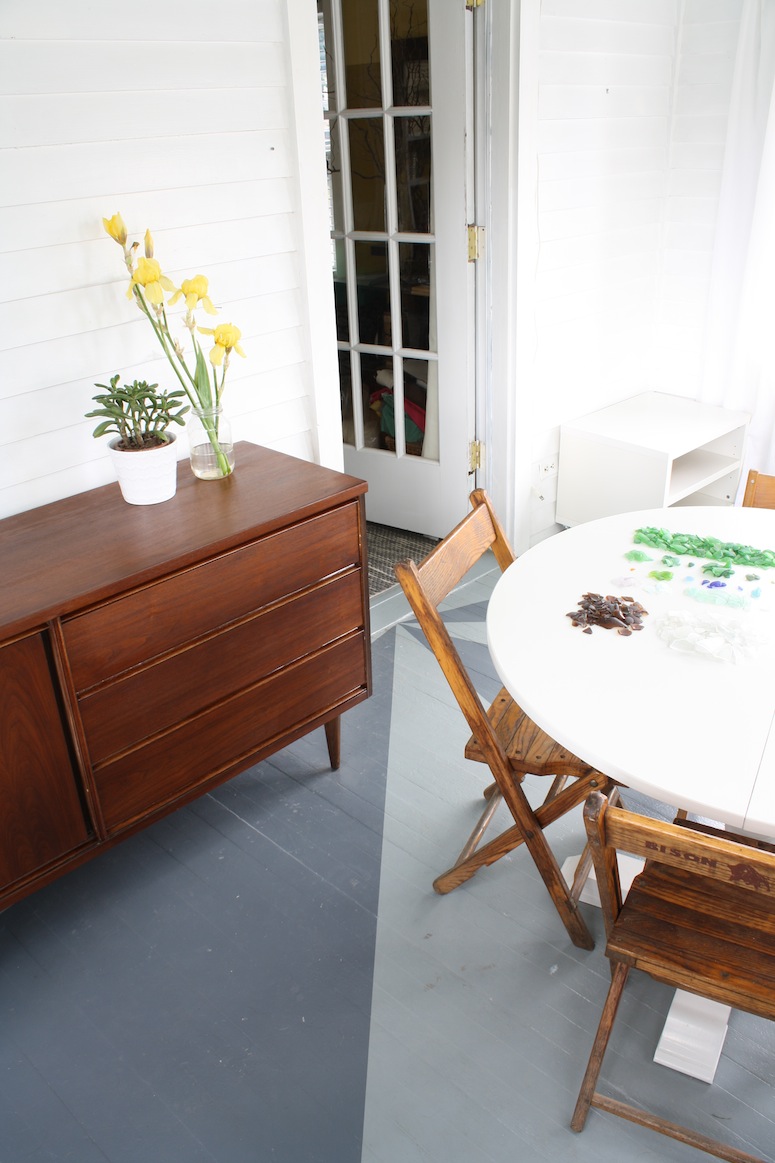
Side note: The mounds of glass on the table? We found it at Ontario Beach Park in Rochester, NY. Best haul ever.


Refinish Mid Century Dining Table
Source: https://merrypad.com/2012/06/04/how-to-refinish-mid-century-modern-buffet/
